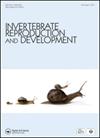Effect of temperature on red snow crab Chionoecetes japonicus (Crustacea, Decapoda, Majoidea) larval survival, development, and growth under laboratory conditions
IF 0.8
4区 生物学
Q4 REPRODUCTIVE BIOLOGY
引用次数: 1
Abstract
ABSTRACT In the Sea of Japan, the mature red snow crab Chionoecetes japonicus is distributed at a depth of 500–2,700 m. However, its planktonic larvae occur at depths shallower than 300 m. To better understand the factors influencing larval dispersal and settlement of the red snow crab in its natural habitat, we tested the effects of temperatures ranging from 1°C to 18°C on the survival, developmental period, and growth of red snow crab zoeal and megalopal larvae. The mean number of days from hatching to second zoeae and megalopae and from megalopae to the first crab instar was significantly shorter at warmer temperatures. Moreover, the relationships between mean temperatures and larval periods were well described by heat summation theory equations and a nonlinear thermodynamic Sharpe-Schoolfield-Ikemoto (SSI) model. The higher survival rate, intrinsic optimum temperatures in the SSI model, and larger carapace width suggested that the optimum temperatures for the development of zoeal and megalopal stages of the red snow crab are 9–10°C and 7–8°C, respectively. A lower optimum temperature in the megalopal stage than in the zoeal stages was considered an adaptation to facilitate deeper vertical distributions in the megalopal stage.温度对实验室条件下赤雪蟹(Chionoecetes japonicus)幼虫存活、发育和生长的影响
摘要在日本海,成熟的日本红雪蟹Chionoecetes japonicus分布在500–2700米的深度。然而,它的浮游幼虫出现在300米以下的深度。为了更好地了解影响红雪蟹幼虫在其自然栖息地扩散和定居的因素,我们测试了1°C至18°C的温度对其生存的影响,红雪蟹幼体和巨幼体的生长、发育期和生长。在温暖的温度下,从孵化到第二个虫科和巨蟹科以及从巨蟹科到第一个蟹龄的平均天数显著缩短。此外,通过热求和理论方程和非线性热力学Sharpe-Schoolfield-Ikemoto(SSI)模型很好地描述了平均温度与幼虫期之间的关系。SSI模型中较高的存活率、固有的最适温度和较大的甲壳宽度表明,红雪蟹幼体和巨幼体阶段发育的最适宜温度分别为9–10°C和7–8°C。巨颚期的最适温度低于幼体期,这被认为是为了促进巨颚期更深的垂直分布。
本文章由计算机程序翻译,如有差异,请以英文原文为准。
求助全文
约1分钟内获得全文
求助全文
来源期刊
CiteScore
1.90
自引率
0.00%
发文量
21
审稿时长
>12 weeks
期刊介绍:
Invertebrate Reproduction & Development ( IRD) presents original research on the reproductive and developmental biology of the Invertebrata, both embryonic and postembryonic. IRD welcomes papers reporting significant results obtained using new techniques. Encouraged topic areas include: aquaculture, physiology, biochemistry, functional morphology, phylogeny, behavioural and regulatory mechanisms, including genetic, endocrine and molecular studies. Papers containing qualitative descriptions of reproductive cycles and gametogenesis will not be considered. IRD is published in association with the International Society of Invertebrate Reproduction and Development.

 求助内容:
求助内容: 应助结果提醒方式:
应助结果提醒方式:


